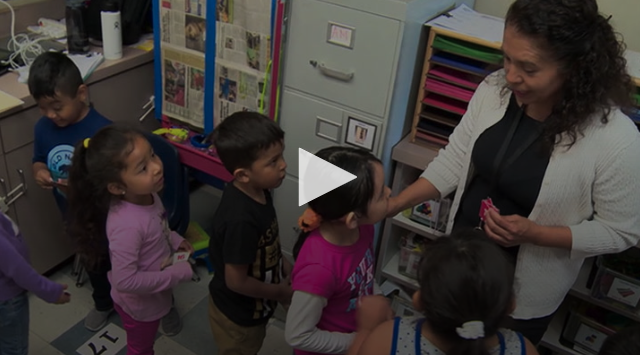Editor’s Note: We’ve asked Special Education teacher Brett Bigham to look at videos in Tch’s library and tell us how he would adapt them for the wide range of learning abilities seen in today’s classrooms. Click on his picture to the left to see the full list of blogs in the series.
I‘m a huge fan of using those lost minutes in a classroom to teach. What Ms. Torres has done here with her “Line Up With Numbers” has reclaimed her line-up time for class time. Most people know that different students learn in different ways and any time we can fit additional visual, audial, and kinesthetic learning into our classrooms, the more opportunities our students have to learn.

By inserting learning into transition times, Ms. Torres has created a moment of intense learning that will help her students figure out their numbers. In its simplicity, this is an extremely effective use of a moment that most teachers would have thrown away.
Since this lesson seems perfect, I can’t see any way to adapt it for different learners. What I do want to support Ms. Torres doing is to take this line-up lesson and create a year-long lesson plan that will make the best use of line-up time.
As the year progresses, this line-up lesson can be used repeatedly for learning different information. Once the students have mastered their numbers, the same set up can be used for the alphabet. Letters and numbers are the most obvious (and easiest) choices for this type of lesson.
To do a deeper dive into this, I put together a list of lessons that would easily work under this line-up system. Once the alphabet is mastered, students can begin working on alphabetizing their names or spelling words. Ms. Torres might even create an alphabetized list of her upcoming spelling words to use.

For many of my students, they need these extra learning opportunities for many of the basics. Any opportunities to layer in extra learning about letters, numbers, common words, shapes, and colors can be very beneficial.
To support Ms. Torres and her students, I‘ve created a couple of “Line Up” programs to be used once number mastery has been met.
This free download has six pages of shapes in different colors. Instead of lining up as number three, a student may be given a blue square or a red octagon to find. These layers of shapes and colors should fit in nicely with the numbers’ line-up directions.
Once students have mastered their numbers, letters, shapes, and colors I would start making “Line-Up” lists using common words. This download here has the most common word for each letter of the alphabet, foods for every letter of the alphabet (except X), and an alphabetized list with a country for each letter.
These alphabetized lists will be excellent starting places for students who know their letters and are ready to move their skills up a notch. If you consider how many times a day students line up, these quick lessons that are repeated throughout the day can have a huge impact on student learning!






